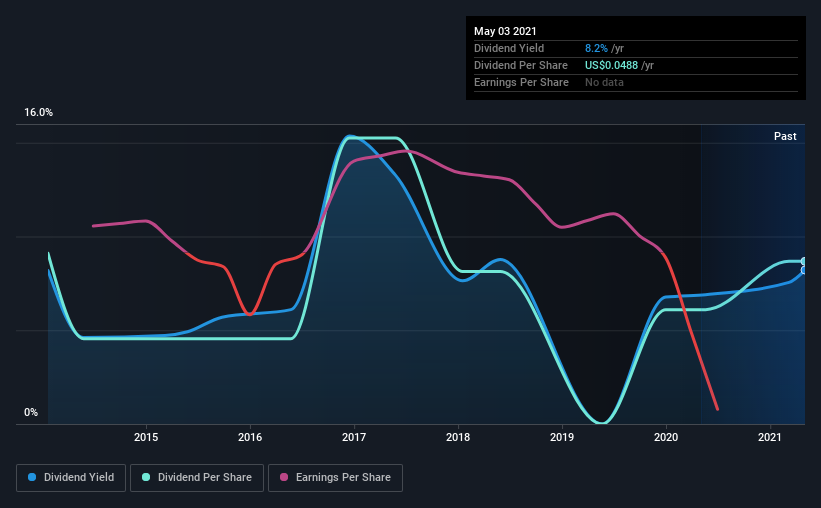- United Kingdom
- /
- Capital Markets
- /
- AIM:LIV
Here's What You Should Know About Livermore Investments Group Limited's (LON:LIV) 8.2% Dividend Yield

Dividend paying stocks like Livermore Investments Group Limited (LON:LIV) tend to be popular with investors, and for good reason - some research suggests a significant amount of all stock market returns come from reinvested dividends. Yet sometimes, investors buy a popular dividend stock because of its yield, and then lose money if the company's dividend doesn't live up to expectations.
With a goodly-sized dividend yield despite a relatively short payment history, investors might be wondering if Livermore Investments Group is a new dividend aristocrat in the making. It sure looks interesting on these metrics - but there's always more to the story. Some simple research can reduce the risk of buying Livermore Investments Group for its dividend - read on to learn more.
Explore this interactive chart for our latest analysis on Livermore Investments Group!

Payout ratios
Dividends are usually paid out of company earnings. If a company is paying more than it earns, then the dividend might become unsustainable - hardly an ideal situation. As a result, we should always investigate whether a company can afford its dividend, measured as a percentage of a company's net income after tax. Although Livermore Investments Group pays a dividend, it was loss-making during the past year. This is a medium payout level that leaves enough capital in the business to fund opportunities that might arise, while also rewarding shareholders. Plus, there is room to increase the payout ratio over time.
We update our data on Livermore Investments Group every 24 hours, so you can always get our latest analysis of its financial health, here.
Dividend Volatility
From the perspective of an income investor who wants to earn dividends for many years, there is not much point buying a stock if its dividend is regularly cut or is not reliable. Looking at the data, we can see that Livermore Investments Group has been paying a dividend for the past seven years. It's good to see that Livermore Investments Group has been paying a dividend for a number of years. However, the dividend has been cut at least once in the past, and we're concerned that what has been cut once, could be cut again. During the past seven-year period, the first annual payment was US$0.05 in 2014, compared to US$0.05 last year. Dividend payments have shrunk at a rate of less than 1% per annum over this time frame.
When a company's per-share dividend falls we question if this reflects poorly on either external business conditions, or the company's capital allocation decisions. Either way, we find it hard to get excited about a company with a declining dividend.
Dividend Growth Potential
With a relatively unstable dividend, it's even more important to see if earnings per share (EPS) are growing. Why take the risk of a dividend getting cut, unless there's a good chance of bigger dividends in future? Livermore Investments Group's EPS have fallen by approximately 15% per year during the past five years. With this kind of significant decline, we always wonder what has changed in the business. Dividends are about stability, and Livermore Investments Group's earnings per share, which support the dividend, have been anything but stable.
Conclusion
To summarise, shareholders should always check that Livermore Investments Group's dividends are affordable, that its dividend payments are relatively stable, and that it has decent prospects for growing its earnings and dividend. Firstly, we like that Livermore Investments Group has a low and conservative payout ratio. Second, earnings per share have been in decline, and its dividend has been cut at least once in the past. Livermore Investments Group might not be a bad business, but it doesn't show all of the characteristics we look for in a dividend stock.
Investors generally tend to favour companies with a consistent, stable dividend policy as opposed to those operating an irregular one. Meanwhile, despite the importance of dividend payments, they are not the only factors our readers should know when assessing a company. To that end, Livermore Investments Group has 6 warning signs (and 2 which are a bit unpleasant) we think you should know about.
Looking for more high-yielding dividend ideas? Try our curated list of dividend stocks with a yield above 3%.
If you decide to trade Livermore Investments Group, use the lowest-cost* platform that is rated #1 Overall by Barron’s, Interactive Brokers. Trade stocks, options, futures, forex, bonds and funds on 135 markets, all from a single integrated account. Promoted
New: AI Stock Screener & Alerts
Our new AI Stock Screener scans the market every day to uncover opportunities.
• Dividend Powerhouses (3%+ Yield)
• Undervalued Small Caps with Insider Buying
• High growth Tech and AI Companies
Or build your own from over 50 metrics.
This article by Simply Wall St is general in nature. It does not constitute a recommendation to buy or sell any stock, and does not take account of your objectives, or your financial situation. We aim to bring you long-term focused analysis driven by fundamental data. Note that our analysis may not factor in the latest price-sensitive company announcements or qualitative material. Simply Wall St has no position in any stocks mentioned.
*Interactive Brokers Rated Lowest Cost Broker by StockBrokers.com Annual Online Review 2020
Have feedback on this article? Concerned about the content? Get in touch with us directly. Alternatively, email editorial-team (at) simplywallst.com.
About AIM:LIV
Flawless balance sheet average dividend payer.
Market Insights
Community Narratives




